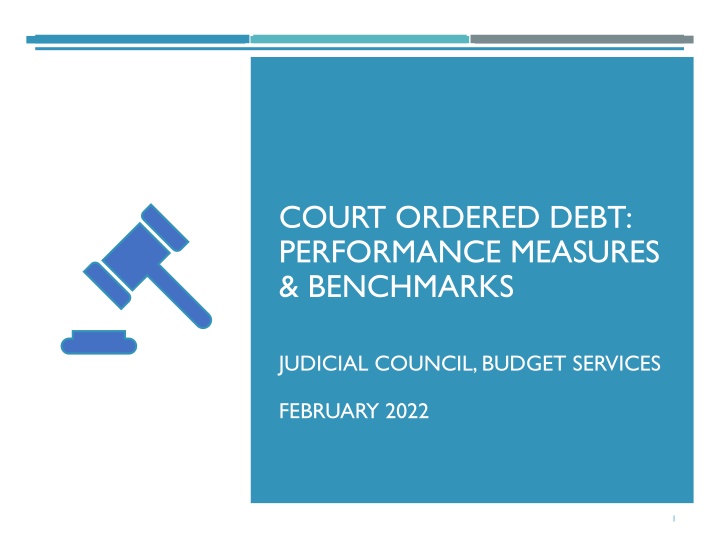
Court-Ordered Debt Performance Measures and Benchmarks
Explore the necessity of Performance Measures and Benchmarks (PMBs) in managing court-ordered debt, the development process, approved PMBs, and changes in collections practices over the years. Discover why PMBs are crucial and how they help in resolving delinquent court-ordered debts effectively.
Download Presentation

Please find below an Image/Link to download the presentation.
The content on the website is provided AS IS for your information and personal use only. It may not be sold, licensed, or shared on other websites without obtaining consent from the author. If you encounter any issues during the download, it is possible that the publisher has removed the file from their server.
You are allowed to download the files provided on this website for personal or commercial use, subject to the condition that they are used lawfully. All files are the property of their respective owners.
The content on the website is provided AS IS for your information and personal use only. It may not be sold, licensed, or shared on other websites without obtaining consent from the author.
E N D
Presentation Transcript
COURT ORDERED DEBT: PERFORMANCE MEASURES & BENCHMARKS JUDICIAL COUNCIL, BUDGET SERVICES FEBRUARY 2022 1
DELINQUENT COURT ORDERED DEBT Court-ordered debt can be processed by one or more of these programs: 58 court/county programs 13 private collection agencies 2 Franchise Tax Board programs (COD and IIC) 2 Intra-branch programs (Ventura Court, Shasta Court) Until paid in full or discharged from accountability deemed uncollectible 2
WHY ARE PMBS NEEDED? HOW WERE PMBS DEVELOPED? PERFORMANCE MEASURES AND BENCHMARKS (PMB) PROPOSED PMBS 3
WHY ARE PMBS NEEDED? Changes in statute and collections practices: Senate Bill 940 (stats. 2003, ch. 275) Required Judicial Council to develop collections-related guidelines. Assembly Bill 367 (Stats. 2007, ch. 132) Required Judicial Council to develop performance measure and benchmarks. 4
CURRENTLY APPROVED PMB Performance Measure Definition Formula Benchmark Measures ability to resolve delinquent court-ordered debt. Gross Recovery Rate (GRR) Collections + Adjustments+ Discharge ----------------------------------------- Referrals 34% Measures revenue on delinquent court-ordered debt based on total delinquent accounts referred, after adjustments, including NSF checks. Success Rate (SR) Collections 31% ------------------------------------- Referrals-Adjustments-Discharge
CHANGES IN COLLECTIONS 2014 Legislative Analyst s Office conducted a study of the statewide programs and found it difficult to comprehensively evaluate and compare the performance of existing collection programs due to a lack of complete, consistent, and accurate reporting on how programs collect debt. Assembly Bill103 (Stats. 2017, ch. 17) 2017 Government Code section 68514 required the programs to report additional collections information. Required Judicial Council to expand reporting practices and template Last decade several mechanisms implemented to help individuals resolve their court-ordered debt using alternative methods in lieu of cash payment; custody credits, community service, ability to pay. In light of the changes in collections, it was determined that the current approved PMBs needed to be revisited.
HOW WERE THE PMBS DEVELOPED 7
DEVELOPMENT OF PMBS: Forrester Consulting, Inc., (Forrester) retained to analyze data and update PMB to align with reporting requirements. Forrester: Analyzed Collections Data Collaborated with Subject Matter Experts (SME) Developed Initial PMBs Proposed PMBs Introduced Proposed PMBs Presented to CEAC Solicited Feedback from Collections Programs 8
SUBJECT MATTER EXPERTS Monterey County Treasurer-Tax Collector's Office Mr. Jake Stroud, Chief Deputy Treasurer-Tax Collector Superior Court of Monterey County Mr. Colin Simpson, Chief Financial Officer 9
RECOMMENDED METRICS Performance Metrics Normalizing Metrics Collector Effective Index (CEI) Adjustment Score First-year Resolution Rate Discharge Score Spend Efficiency Score (SES) Risk Monitor Cost to Referral ratio
COLLECTOR EFFECTIVE INDEX (CEI) Definition: The Collector Effective Index (CEI) shows the percentage of referrals with payment received versus total referrals of that age. What it Means: CEI shows an entity s effectiveness at collecting referrals of a specific age by calculating the percentage of cases with payment for debts of a specific, pre- determined age. CEI give a numeric (percentage) and visual representation of how an entity is performing versus peers in collecting referrals of a specific age. Entities should strive to maximize CEI for both Current and Prior referrals. 11
FIRST-YEAR RESOLUTION RATE Definition: First-year Resolution is the percentage of 'current' referral balance that was resolved within the first year. What it Means: How effective entities are at collecting and resolving first-year (current) referrals within that year This shows the percentage of current referral dollars that were resolved within the first year through collections, adjustments and/or discharges. Higher percentages mean an entity was able to resolve more first-year debt. Entities should strive to make First-year Resolution Rate as high as possible. First-year Resolution: o Green = Higher (good, more referrals resolved in 1st year) o Yellow = lower (improvement, fewer referrals resolved in 1st year) 12
SPEND EFFICIENCY SCORE Definition: The Spend Efficiency Score is the number of dollars spent to collect $1 in delinquent referrals for the various programs. What it Means: SES shows the cost to collect $1 in delinquent referrals. An SES for Private Agency of 0.2 means that an entity spent 20 cents to collect each dollar of delinquent referrals when using that program. Low SES means an entity is spending less to collect delinquent referrals, a high SES means an entity is spending more to collect delinquent referrals. An SES greater than 1 should always be investigated. 13
Definition: Cost to Referral ratio show the average dollars spent (costs) per referral. What it Means: The Cost to Referral ratio is helpful when entities are looking to compare relative operating costs with other entities, and to the cost of administering justice. This benchmark shows the average cost-per-referral for current, prior, and combined referrals, in addition to the cost- per-total cases resolved. COST TO REFERRAL RATIO 14
ADJUSTMENT SCORE Definition: Adjustment Score is a representation of the dollar value of adjustments against the total referral balance. What it Means: The relative amount of revenue that an entity adjusted through non-cash means. The adjustment score is a normalizing metric and is intended to help entities understand where they stand in terms of adjustments with the other entities in their cluster. 15
DISCHARGE SCORE Definition: Discharge Score is a representation of the dollar value of discharges against the total referral balance. What it Means: The relative amount of revenue that an entity discharged. The discharge score is a normalizing metric and is intended to help entities understand where they stand in terms of discharges with the other entities in their cluster. 16
RISK MONITOR Definition: The Risk Monitor is the percentage of referrals that went delinquent out of the total current referral pool for that year. What it Means: The Risk Monitor is designed to assign a riskiness score to an entity s current year referrals to help the entity (and JCC) set expectations for performance on those specific referrals. A high-Risk Monitor means fewer referrals were paid before going delinquent and the remaining pool is riskier A low-Risk Monitor means more referrals were paid before going delinquent and the remaining pool is less risky 17






















